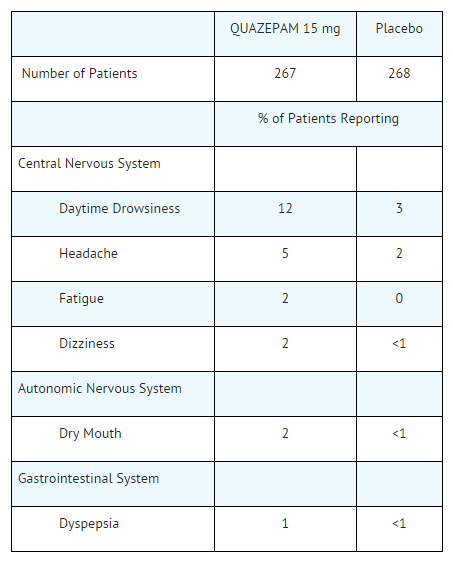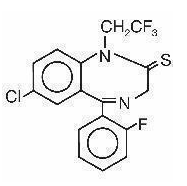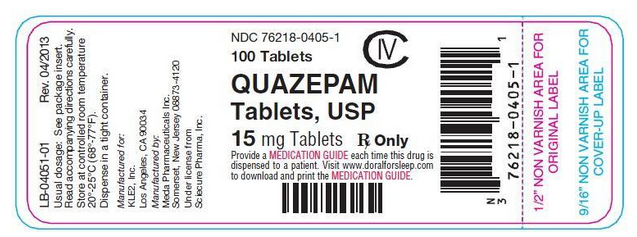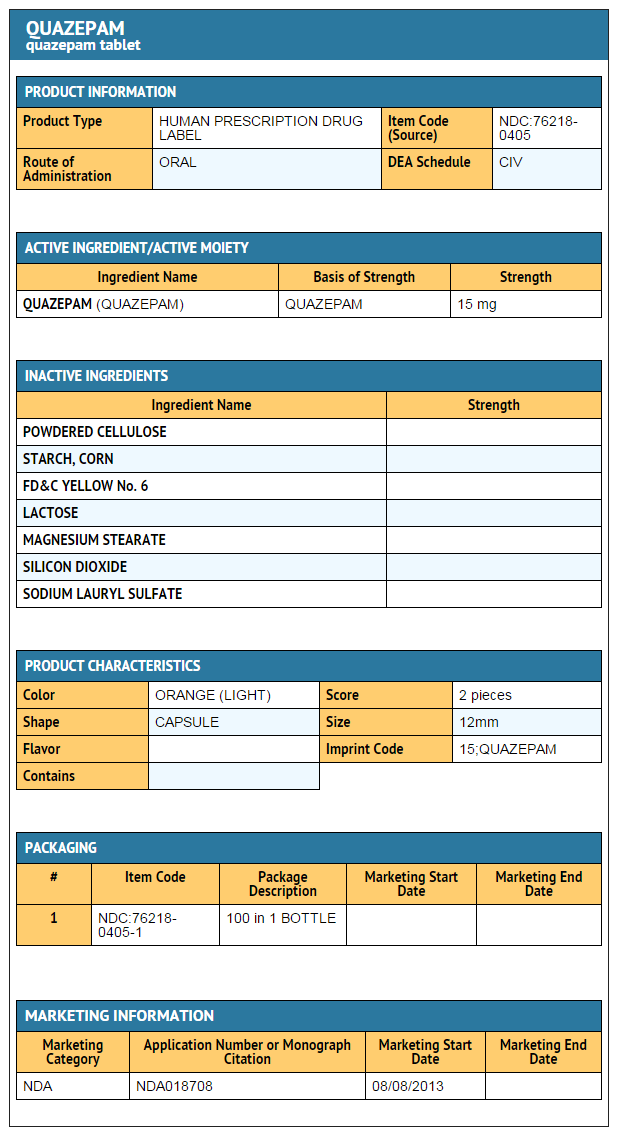Quazepam
Editor-In-Chief: C. Michael Gibson, M.S., M.D. [1]; Associate Editor(s)-in-Chief: Rabin Bista, M.B.B.S. [2]
Disclaimer
WikiDoc MAKES NO GUARANTEE OF VALIDITY. WikiDoc is not a professional health care provider, nor is it a suitable replacement for a licensed healthcare provider. WikiDoc is intended to be an educational tool, not a tool for any form of healthcare delivery. The educational content on WikiDoc drug pages is based upon the FDA package insert, National Library of Medicine content and practice guidelines / consensus statements. WikiDoc does not promote the administration of any medication or device that is not consistent with its labeling. Please read our full disclaimer here.
Overview
Quazepam is a Benzodiazepine that is FDA approved for the treatment of insomnia characterized by difficulty falling asleep, frequent nocturnal awakenings, and/or early morning awakenings. Common adverse reactions include drowsiness, headache, fatigue, dizziness, dry mouth, dyspepsia.
Adult Indications and Dosage
FDA-Labeled Indications and Dosage (Adult)
Indications
- QUAZEPAM® (quazepam) is indicated for the treatment of insomnia characterized by difficulty in falling asleep, frequent nocturnal awakenings, and/or early morning awakenings. The effectiveness of QUAZEPAM has been established in placebo-controlled clinical studies of 5 nights duration in acute and chronic insomnia. The sustained effectiveness of QUAZEPAM has been established in chronic insomnia in a sleep lab (polysomnographic) study of 28 nights duration. Because insomnia is often transient and intermittent, the prolonged administration of QUAZEPAM Tablets is generally not necessary or recommended. Since insomnia may be a symptom of several other disorders, the possibility that the complaint may be related to a condition for which there is a more specific treatment should be considered.
Dosage
- Use the lowest dose effective for the patient, as important adverse effects of QUAZEPAM are dose related.
- The recommended initial dose is 7.5 mg. The 7.5 mg dose can be increased to 15 mg if necessary for efficacy.
- The 7.5 mg dose can be achieved by splitting the 15 mg tablet along the score line.
Special Populations
- Elderly and debilitated patients may be more sensitive to benzodiazepines.
DOSAGE FORMS AND STRENGTHS
- Tablets, 15 mg, functionally scored, capsule-shaped, light orange, slightly white speckled tablets, impressed with the product identification number 15 on one side of the tablet, and the product name (QUAZEPAM) on the other.
Off-Label Use and Dosage (Adult)
Guideline-Supported Use
There is limited information regarding Off-Label Guideline-Supported Use of Quazepam in adult patients.
Non–Guideline-Supported Use
There is limited information regarding Off-Label Non–Guideline-Supported Use of Quazepam in adult patients.
Pediatric Indications and Dosage
FDA-Labeled Indications and Dosage (Pediatric)
There is limited information regarding FDA-Labeled Use of Quazepam in pediatric patients.
Off-Label Use and Dosage (Pediatric)
Guideline-Supported Use
There is limited information regarding Off-Label Guideline-Supported Use of Quazepam in pediatric patients.
Non–Guideline-Supported Use
There is limited information regarding Off-Label Non–Guideline-Supported Use of Quazepam in pediatric patients.
Contraindications
- QUAZEPAM is contraindicated in patients with known hypersensitivity to quazepam or other benzodiazepines. Rare cases of angioedema involving the tongue, glottis or larynx have been reported in patients after taking the first or subsequent doses of QUAZEPAM. Some patients have had additional symptoms such as dyspnea, throat closing, or nausea and vomiting that suggest anaphylaxis. Patients who develop such reactions should not be rechallenged with QUAZEPAM.
- Contraindicated in patients with established or suspected sleep apnea, or with pulmonary insufficiency.
Warnings
CNS-Depressant Effects and Daytime Impairment
- QUAZEPAM is a central nervous system (CNS) depressant and can impair daytime function in some patients even when used as prescribed. Prescribers should monitor for excess depressant effects, but impairment can occur in the absence of subjective symptoms, and may not be reliably detected by ordinary clinical exam (i.e. less than formal psychomotor testing). While pharmacodynamic tolerance or adaptation to some adverse depressant effects of QUAZEPAM may develop, patients using QUAZEPAM should be cautioned against driving or engaging in other hazardous activities or activities requiring complete mental alertness.
- Additive effects occur with concomitant use of other CNS depressants (e.g., other benzodiazepines, opioids, tricyclic antidepressants, alcohol), including daytime use. Downward dose adjustment of QUAZEPAM and concomitant CNS depressants should be considered. The potential for adverse drug interactions continues for several days following discontinuation of QUAZEPAM, until serum levels of both active parent drug and psychoactive metabolites decline.
- Use of QUAZEPAM with other sedative-hypnotics is not recommended. Alcohol generally should not be used during treatment with QUAZEPAM. The risk of next-day psychomotor impairment is increased if QUAZEPAM is taken with less than a full night of sleep remaining (7- to 8 hours); if higher than the recommended dose is taken; if co-administered with other CNS depressants.
Benzodiazepine Withdrawal Syndrome
- A withdrawal syndrome similar to that from alcohol (e.g., convulsions, tremor, abdominal and muscle cramps, vomiting, and sweating) can occur following abrupt discontinuation of QUAZEPAM. The more severe withdrawal effects are usually limited to patients taking higher than recommended doses over an extended time. Abrupt discontinuation should be avoided in such patients, and the dose gradually tapered. Prescribers should monitor patients for tolerance, abuse, and dependence.
- Milder withdrawal symptoms (e.g., dysphoria and insomnia) can occur following abrupt discontinuation of benzodiazepines taken at therapeutic levels for short periods.
Need to Evaluate for Co-morbid Disorders
- Because sleep disturbances may be the presenting manifestation of a physical and/or psychiatric disorder, symptomatic treatment of insomnia should be initiated only after a careful evaluation of the patient. The failure of insomnia to remit after 7 to 10 days of treatment may indicate the presence of a primary psychiatric and/or medical illness that should be evaluated. Worsening of insomnia or the emergence of new thinking or behavior abnormalities may be the consequence of an unrecognized psychiatric or physical disorder. Such findings have emerged during the course of treatment with sedative-hypnotic drugs.
Severe Anaphylactic or Anaphylactoid Reactions
- Rare cases of angioedema involving the tongue, glottis or larynx have been reported in patients after taking the first or subsequent doses of sedative-hypnotics, including QUAZEPAM. Some patients have had additional symptoms such as dyspnea, throat closing, or nausea and vomiting that suggest anaphylaxis.
- Some patients have required medical therapy in the emergency department. If angioedema involves the tongue, glottis or larynx, airway obstruction may occur and be fatal. Patients who develop angioedema after treatment with QUAZEPAM should not be rechallenged with the drug.
Abnormal Thinking and Behavior Changes
- Abnormal thinking and behavior changes have been reported in patients treated with sedative-hypnotics including QUAZEPAM. Some of these changes include decreased inhibition (e.g., aggressiveness and extroversion that seemed out of character), bizarre behavior, and depersonalization. Visual and auditory hallucinations have also been reported. Amnesia, and other neuro-psychiatric symptoms may occur.
- Paradoxical reactions such as stimulation, agitation, increased muscle spasticity, and sleep disturbances may occur unpredictably.
- Complex behaviors such as "sleep-driving" (i.e., driving while not fully awake, with amnesia for the event) have been reported with use of sedative-hypnotics. These behaviors can occur with initial treatment or in patients previously tolerant of QUAZEPAM or other sedative-hypnotics. Although these behaviors can occur with use at therapeutic doses, risk is increased by higher doses or concomitant use of alcohol or other CNS depressants. Due to risk to the patient and community, QUAZEPAM should be discontinued if "sleep-driving" occurs.
- Other complex behaviors (e.g., preparing and eating food, making phone calls, or having sex) have been reported in patients who are not fully awake after taking a sedative-hypnotic. As with sleep-driving, patients usually do not remember these events.
Worsening of Depression
- Benzodiazepines may worsen depression. Consequently, appropriate precautions (e.g., limiting the total prescription size and increased monitoring for suicidal ideation) should be considered.
Adverse Reactions
Clinical Trials Experience
- The following serious adverse reactions are discussed in greater detail in other sections of the label:
- CNS-depressant effects and next-day impairment
- Benzodiazepine withdrawal syndrome
- Abnormal thinking and behavior changes, and complex behaviors
- Worsening of depression
Clinical Studies Experience
- Because clinical trials are conducted under widely varying conditions, adverse reaction rates observed in the clinical trials of a drug cannot be directly compared to rates in the clinical trials of another drug and may not reflect the rates observed in clinical practice.
- The table shows adverse reactions occurring at an incidence of 1% or greater in relatively short-duration, placebo-controlled clinical trials of QUAZEPAM. Because clinical trials are conducted under widely varying conditions, adverse reaction rates observed in the clinical trials of a drug cannot be directly compared to rates in the clinical trials of another drug and may not reflect the rates observed in actual practice.
- A double-blind, controlled sleep laboratory study (N=30) in elderly patients compared the effects of quazepam 7.5 mg and 15 mg to that of placebo over a period of 7 days. Both the 7.5 mg and 15 mg doses appeared to be well tolerated. Caution must be used in interpreting this data due to the small size of the study.
Postmarketing Experience
There is limited information regarding Quazepam Postmarketing Experience in the drug label.
Drug Interactions
- Benzodiazepines, including QUAZEPAM, produce additive CNS depressant effects when co-administered with ethanol or other CNS depressants (e.g. psychotropic medications, anticonvulsants, antihistamines). Downward dose adjustment of QUAZEPAM and/or concomitant CNS depressants may be necessary because of additive effects.
Use in Specific Populations
Pregnancy
- There are no adequate and well-controlled studies in pregnant women. Administration of benzodiazepines immediately prior to or during childbirth can result in a syndrome of hypothermia, hypotonia, respiratory depression, and difficulty feeding. In addition, infants born to mothers who have taken benzodiazepines during the later stages of pregnancy can development dependence, and subsequently withdrawal, during the postnatal period. Although administration of quazepam to pregnant animals did not indicate a risk for adverse effects on morphological development at clinically relevant doses, data for other benzodiazepines suggest the possibility of adverse developmental effects (long-term effects on neurobehavioral and immunological function) in animals following prenatal exposure to benzodiazepines. QUAZEPAM should be used during pregnancy only if the potential benefit justifies the potential risk to the fetus.
- Developmental toxicity studies of quazepam in mice at doses up to 400 times the human dose (15 mg) revealed no major drug-related malformations. Minor fetal skeletal variations that occurred were delayed ossification of the sternum, vertebrae, distal phalanges and supraoccipital bones, at doses approximately 70 and 400 times the human dose. A developmental toxicity study of quazepam in New Zealand rabbits at doses up to approximately 130 times the human dose demonstrated no effect on fetal morphology or development of offspring.
- Australian Drug Evaluation Committee (ADEC) Pregnancy Category
There is no Australian Drug Evaluation Committee (ADEC) guidance on usage of Quazepam in women who are pregnant.
Labor and Delivery
There is no FDA guidance on use of Quazepam during labor and delivery.
Nursing Mothers
- Quazepam and its metabolites are excreted in human milk. Caution should be exercised when administering QUAZEPAM to a nursing woman.
Pediatric Use
- Safety and effectiveness in pediatric patients have not been established.
Geriatic Use
- QUAZEPAM may cause confusion and over-sedation in the elderly. Elderly patients generally should be started on a low dose of QUAZEPAM and observed closely.
- Elderly and debilitated patients may be more sensitive to benzodiazepines, reflecting the greater frequency of decreased hepatic, renal, or cardiac function, and of concomitant disease or other drug therapy.
- A double-blind controlled sleep laboratory study (N=30) compared the effects of quazepam 7.5 mg and 15 mg to that of placebo over a period of 7 days. Both the 7.5 mg and 15 mg doses appeared to be well tolerated. Caution must be used in interpreting this data due to the small size of the study.
Gender
There is no FDA guidance on the use of Quazepam with respect to specific gender populations.
Race
There is no FDA guidance on the use of Quazepam with respect to specific racial populations.
Renal Impairment
There is no FDA guidance on the use of Quazepam in patients with renal impairment.
Hepatic Impairment
There is no FDA guidance on the use of Quazepam in patients with hepatic impairment.
Females of Reproductive Potential and Males
There is no FDA guidance on the use of Quazepam in women of reproductive potentials and males.
Immunocompromised Patients
There is no FDA guidance one the use of Quazepam in patients who are immunocompromised.
Administration and Monitoring
Administration
- Oral
Monitoring
- Prescribers should monitor for excess depressant effects, but impairment can occur in the absence of subjective symptoms, and may not be reliably detected by ordinary clinical exam
- Prescribers should monitor patients for tolerance, abuse, and dependence.
- Benzodiazepines may worsen depression. Consequently, appropriate precautions (e.g., limiting the total prescription size and increased monitoring for suicidal ideation) should be considered.
IV Compatibility
There is limited information regarding IV Compatibility of Quazepam in the drug label.
Overdosage
- Contact a poison control center for up-to-date information on the management of benzodiazepine overdose.
- Manifestations of QUAZEPAM overdose include somnolence, confusion, and coma. General supportive measures should be employed, along with immediate gastric lavage. Dialysis is of limited value. Flumazenil may be useful, but can contribute to the appearance of neurological symptoms including convulsions. Hypotension may be treated by appropriate medical intervention. Animal experiments suggest that forced diuresis or hemodialysis are of little value in treating QUAZEPAM overdose. As with the management of intentional overdose with any drug, the possibility of multiple drug ingestion should be considered.
DRUG ABUSE AND DEPENDENCE
Controlled Substance
- Quazepam is classified as a Schedule IV controlled substance by federal regulation.
Abuse and Dependence
- Addiction-prone individuals (e.g. history of drug addiction or alcoholism) should be under careful surveillance when receiving QUAZEPAM because of increased risk of abuse and dependence. Benzodiazepine withdrawal symptoms can occur following discontinuation of QUAZEPAM.
- Abuse and addiction are separate and distinct from physical dependence and tolerance. Abuse is characterized by misuse of the drug for non-medical purposes, often in combination with other psychoactive substances. Physical dependence is a state of adaptation that is manifested by a specific withdrawal syndrome that can be produced by abrupt cessation, rapid dose reduction, decreasing blood level of the drug and/or administration of an antagonist. Tolerance is a state of adaptation in which exposure to a drug induces changes that result in a diminution of one or more of the drug’s effects over time. Tolerance may occur to both the desired and undesired effects of drugs and may develop at different rates for different effects.
- Addiction is a primary, chronic, neurobiological disease with genetic, psychosocial, and environmental factors influencing its development and manifestations. It is characterized by behaviors that include one or more of the following: impaired control over drug use, compulsive use, continued use despite harm, and craving. Drug addiction is a treatable disease, utilizing a multidisciplinary approach, but relapse is common.
Pharmacology
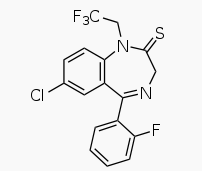
| |
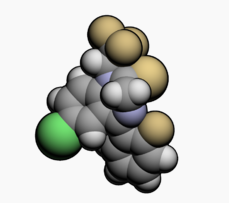
| |
Quazepam
| |
| Systematic (IUPAC) name | |
| 7-Chloro-5-(2-fluorophenyl)-1-(2,2,2-trifluoroethyl)-1,3-dihydro-2H-1,4-benzodiazepin-2-thione | |
| Identifiers | |
| CAS number | |
| ATC code | N05 |
| PubChem | |
| DrugBank | |
| Chemical data | |
| Formula | Template:OrganicBox atomTemplate:OrganicBox atomTemplate:OrganicBoxTemplate:OrganicBoxTemplate:OrganicBoxTemplate:OrganicBoxTemplate:OrganicBox atomTemplate:OrganicBoxTemplate:OrganicBox atomTemplate:OrganicBoxTemplate:OrganicBoxTemplate:OrganicBoxTemplate:OrganicBoxTemplate:OrganicBox atomTemplate:OrganicBoxTemplate:OrganicBoxTemplate:OrganicBoxTemplate:OrganicBoxTemplate:OrganicBox atomTemplate:OrganicBoxTemplate:OrganicBoxTemplate:OrganicBoxTemplate:OrganicBox |
| Mol. mass | 386.795 g/mol |
| SMILES | & |
| Pharmacokinetic data | |
| Bioavailability | 29–35% |
| Metabolism | Hepatic |
| Half life | 39 hours |
| Excretion | Renal |
| Therapeutic considerations | |
| Pregnancy cat. | |
| Legal status | |
| Routes | Oral |
Mechanism of Action
- Quazepam, like other central nervous system agents of the 1,4-benzodiazepine class, presumably exerts its effects by binding to stereo-specific receptors at several sites within the central nervous system (CNS). The exact mechanism of action is unknown.
Structure
- QUAZEPAM contains quazepam, a trifluoroethyl benzodiazepine hypnotic agent, having the chemical name 7-chloro-5- (o-fluoro-phenyl)-1,3-dihydro-1-(2,2,2-trifluoroethyl)-2H-1,4-benzodiazepine-2-thione and the following structural formula:
- Quazepam has the empirical formula C17H11CIF4N2S, and a molecular weight of 386.8. It is a white crystalline compound, soluble in ethanol and insoluble in water. Each QUAZEPAM Tablet contains 15 mg of quazepam. The inactive ingredients for QUAZEPAM Tablets include cellulose, corn starch, FD&C Yellow No. 6 Al Lake, lactose, magnesium stearate, silicon dioxide, and sodium lauryl sulfate.
Pharmacodynamics
There is limited information regarding Pharmacodynamics of Quazepam in the drug label.
Pharmacokinetics
Absorption
- Quazepam is rapidly (absorption half-life of about 30 minutes) and well absorbed from the gastrointestinal tract. The peak plasma concentration of quazepam is approximately 20 ng/mL after a 15 mg dose and occurs at about 2 hours.
Metabolism
- Quazepam, the active parent compound, is extensively metabolized in the liver; two of the plasma metabolites are 2-oxoquazepam and N-desalkyl-2-oxoquazepam. All three compounds show CNS depressant activity.
Distribution
- The degree of plasma protein binding for quazepam and its two major metabolites is greater than 95%.
Elimination
- Following administration of 14C-quazepam, 31% of the dose appeared in the urine and 23% in the feces over five days; only trace amounts of unchanged drug were present in the urine.
- The mean elimination half-life of quazepam and 2-oxoquazepam is 39 hours and that of N-desalkyl-2-oxoquazepam is 73 hours. Steady-state levels of quazepam and 2-oxoquazepam are attained by the seventh daily dose and that of N-desalkyl-2-oxoquazepam by the thirteenth daily dose.
Special Populations
- Geriatrics: The pharmacokinetics of quazepam and 2-oxoquazepam in geriatric subjects are comparable to those seen in young adults; as with desalkyl metabolites of other benzodiazepines, the elimination half-life of N-desalkyl-2-oxoquazepam in geriatric patients is about twice that of young adults.
Drug Interactions
- Bupropion (a CYP2B6 substrate): Co-administration of a single dose of 150 mg Bupropion Hydrochloride XL with steady state quazepam did not significantly affect the AUC and Cmax of bupropion or its primary metabolite, hydroxybupropion.
Nonclinical Toxicology
Carcinogenesis, Mutagenesis, Impairment of Fertility
Carcinogenesis
- Quazepam showed no evidence of carcinogenicity in oral carcinogenicity studies in mice and hamsters.
Mutagenesis
- Quazepam was negative in the bacterial reverse mutation (Ames) assay and equivocal in the mouse lymphoma tk assay.
Impairment of Fertility
- Reproduction studies in mice conducted with quazepam at doses equal to 60 and 180 times the human dose of 15 mg produced slight reductions in fertility rate. Similar reductions in fertility rate have been reported in mice dosed with other benzodiazepines, and is believed to be related to the sedative effects of these drugs at high doses..
Clinical Studies
- The effectiveness of QUAZEPAM was established in placebo-controlled clinical studies of 5 nights duration in acute and chronic insomnia. The sustained effectiveness of QUAZEPAM was established in chronic insomnia in a sleep laboratory (polysomnographic) study of 28 nights duration.
- In the sleep laboratory study, QUAZEPAM significantly decreased sleep latency and total wake time, and significantly increased total sleep time and percent sleep time, for one or more nights. QUAZEPAM 15 mg was effective on the first night of administration. Sleep latency, total wake time and wake time after sleep onset were still decreased and percent sleep time was still increased for several nights after the drug was discontinued. Percent slow wave sleep was decreased, and REM sleep was essentially unchanged. No transient sleep disturbance, such as “rebound insomnia,” was observed after withdrawal of the drug in sleep laboratory studies in 12 patients using 15 mg doses.
- In outpatient studies, QUAZEPAM Tablets improved all subjective measures of sleep including sleep latency, duration of sleep, number of awakenings, occurrence of early morning awakening, and sleep quality. Some effects were evident on the first night of administration of QUAZEPAM (sleep latency, number of awakenings, and duration of sleep).
- A double-blind, controlled sleep laboratory study (N=30) in elderly patients compared the effects of quazepam 7.5 mg and 15 mg to that of placebo over a period of 7 days. Both the 7.5 mg and 15 mg doses appeared to be effective. Caution must be used in interpreting this data due to the small size of the study.
How Supplied
- QUAZEPAM Tablets, 15 mg, functionally scored, capsule-shaped, light orange, slightly white speckled tablets, impressed with the product identification number 15 on one side of the tablet, and the product name (QUAZEPAM) on the other.
- 15 mg Bottles of 100 NDC 63004-7334-1
Storage
- Store QUAZEPAM® Tablets at controlled room temperature 20°-25°C (68°-77°F).
Images
Drug Images
{{#ask: Page Name::Quazepam |?Pill Name |?Drug Name |?Pill Ingred |?Pill Imprint |?Pill Dosage |?Pill Color |?Pill Shape |?Pill Size (mm) |?Pill Scoring |?NDC |?Drug Author |format=template |template=DrugPageImages |mainlabel=- |sort=Pill Name }}
Package and Label Display Panel
PRINCIPAL DISPLAY PANEL
Package Label – Principal Display Panel – 15mg 100 Tablet Carton
100 tablets QUAZEPAM (quazepam tablets, USP) C-IV 15 mg Tablets Provide a MEDICATION GUIDE each time this drug is dispensed to a patient. MEDICATION GUIDES are enclosed. Rx only
Ingredients and Appearance
{{#ask: Label Page::Quazepam |?Label Name |format=template |template=DrugLabelImages |mainlabel=- |sort=Label Page }}
Patient Counseling Information
- See FDA-approved patient labeling (Medication Guide).
- Inform patients about the benefits and risks of QUAZEPAM, stressing the importance of use as directed. Assist patients in understanding the Medication Guide and instruct them to read it with each prescription refill.
- CNS depressant Effects and Next-Day Impairment
- Tell patients that QUAZEPAM can cause next-day impairment, even in the absence of symptoms. Caution patients against driving or engaging in other hazardous activities or activities requiring complete mental alertness when using QUAZEPAM. Tell patients that daytime impairment may persist for several days following discontinuation of QUAZEPAM.
- Withdrawal
- Instruct patients to contact you before stopping or decreasing the dose of QUAZEPAM, because withdrawal symptoms can occur.
- Abnormal thinking and behavior change
- Instruct patients that sedative hypnotics can cause abnormal thinking and behavior change, including “sleep-driving” and other complex behaviors while not being fully awake (preparing and eating food, making phone calls, or having sex). Tell patients to call you immediately if they develop any of these symptoms.
- Severe Allergic Reactions
- Inform patients that severe allergic reactions can occur from QUAZEPAM. Describe the signs/symptoms of these reactions and advise patients to seek medical attention immediately if these occur.
- Suicide
- Tell patients that QUAZEPAM can worsen depression, and to immediately report any suicidal thoughts.
- Alcohol and other drugs
- Ask patients about alcohol consumption, medicines they are taking now, and drugs they may be taking without a prescription. Advise patients that alcohol generally should not be used during treatment with QUAZEPAM.
- Pregnancy
- Instruct patients to inform you if they are nursing or pregnant, or may become pregnant while taking QUAZEPAM.
- Tolerance, Abuse, and Dependence
- Tell patients not to increase the dose of QUAZEPAM on their own, and to inform you if they believe the drug “does not work”.
MEDICATION GUIDE
MEDICATION GUIDE
QUAZEPAM (DOR-al)
(quazepam)
Tablets (C-IV)
- Read the Medication Guide that comes with QUAZEPAM before you start taking it and each time you get a refill. There may be new information. This Medication Guide does not take the place of talking to your healthcare provider about your medical condition or treatment.
What is the most important information I should know about QUAZEPAM?
- QUAZEPAM may cause serious side effects that you may not know are happening to you. These side effects include:
- sleepiness during the day
- not thinking clearly
- act strangely, confused, or upset
- “sleep-walking” or doing other activities when you are asleep like:
- eating
- talking
- having sex
- driving a car
- Call your healthcare provider right away if you find out that you have done any of the above activities after taking QUAZEPAM.
What is QUAZEPAM?
- QUAZEPAM is a prescription medicine used to treat certain types of insomnia including difficulty falling asleep, waking up often during the night, or waking up early in the morning.
- It is not known if QUAZEPAM is safe and effective in children.
- QUAZEPAM is a federally controlled substance (C-IV) because it can be abused or lead to dependence. Keep QUAZEPAM in a safe place to prevent misuse and abuse. Selling or giving away QUAZEPAM may harm others, and is against the law. Tell your healthcare provider if you have ever abused or been dependent on alcohol, prescription medicines or street drugs.
Who should not take QUAZEPAM?
- Do not take QUAZEPAM if you:
- are allergic to quazepam or any of the ingredients in QUAZEPAM. See the end of this Medication Guide for a complete list of ingredients in QUAZEPAM.
- have had an allergic reaction to other sleep medicines or sedatives such as benzodiazepines. Symptoms of a serious allergic reaction to quazepam can include:
- swelling of your face, lips, and throat that may cause difficulty breathing or swallowing
- nausea and vomiting
- have sleep apnea, snoring, breathing or lung problems
- Talk to your healthcare provider before taking this medicine if you have any of these conditions.
What should I tell my healthcare provider before taking QUAZEPAM?
- QUAZEPAM may not be right for you. Before taking QUAZEPAM, tell your healthcare provider about all of your health conditions, including if you:
- have a history of depression, mental illness or, suicidal thoughts
- have a history of drug or alcohol abuse or addiction
- have lung disease or breathing problems
- are pregnant or plan to become pregnant. It is not known if QUAZEPAM can harm your unborn baby.
- are breastfeeding, or plan to breastfeed. QUAZEPAM can pass through your breast milk and may harm your baby. Talk to your healthcare provider about the best way to feed your baby if you take QUAZEPAM.
- Tell your healthcare provider about all of the medicines you take, including prescription and nonprescription medicines, vitamins and herbal supplements.
- Medicines can interact with each other, sometimes causing serious side effects. Do not take QUAZEPAM with other medicines that can make you sleepy unless your healthcare provider tells you to.
- Know the medicines you take. Keep a list of your medicines with you to show your healthcare provider and pharmacist each time you get a new medicine.
How should I take QUAZEPAM?
- See “What is the most important information I should know about QUAZEPAM?”
- Take QUAZEPAM exactly as your healthcare providers tell you to take it.
- Do not stop taking QUAZEPAM without talking to your healthcare provider, drug withdrawal symptoms can happen.
- QUAZEPAM comes in 15 mg tablets. Your healthcare provider may start your QUAZEPAM dose at 7.5 mg which is half a tablet. Talk to your healthcare provider or pharmacist about your dose schedule.
- You should not drink alcohol while you are taking QUAZEPAM.
- Call your healthcare provider if your insomnia worsens or is not better within 7 to 10 days. This may mean that there is another condition causing your sleep problem.
- If you take too much QUAZEPAM or overdose, get emergency treatment right away.
What are the possible side effects of QUAZEPAM?
- QUAZEPAM may cause serious side effects, including:
- getting out of bed while not being fully awake and doing an activity that you do not know you are doing. See “What is the most important information I should know about QUAZEPAM?”
- abnormal thoughts and behavior. Symptoms include more outgoing or aggressive behavior than normal, confusion, agitation, hallucinations, worsening of depression, and suicidal thoughts or actions.
- memory loss
- severe allergic reactions. Symptoms include swelling of the tongue or throat, and trouble breathing. Get emergency medical help right away if you have these symptoms after taking QUAZEPAM.
- Call your healthcare provider right away if you have any of the above side effects or any other side effects that worry you while using QUAZEPAM.
- Common side effects of QUAZEPAM include:
- drowsiness
- headache
- feeling very tired
- dizziness
- dry mouth
- upset stomach
- After you stop taking a sleep medicine, you may have symptoms for the next 1 to 2 days such as:
- trouble sleeping
- nausea
- flushing
- lightheadedness
- uncontrolled crying
- vomiting
- stomach cramps
- panic attack
- nervousness
- stomach area pain
- Tell your healthcare provider if you have any side effect that bothers you or that does not go away.
- These are not all the possible side effects of QUAZEPAM. Ask your healthcare provider or pharmacist for more information.
- Call your doctor for medical advice about side effects. You may report side effects to FDA at 1-800-FDA-1088.
How should I store QUAZEPAM?
- Store at room temperature between 68°F to 77° F (20°C to 25°C).
- Keep QUAZEPAM and all medicines out of the reach of children
General information about the safe and effective use of QUAZEPAM
- Medicines are sometimes prescribed for purposes other than those listed in a Medication Guide. Do not use QUAZEPAM for a condition for which it was not prescribed. Do not share QUAZEPAM with other people, even if they have the same symptoms that you have. It may harm them and it is against the law.
- This Medication Guide summarizes the most important information about QUAZEPAM. If you would like more information about QUAZEPAM, talk with your healthcare provider. You can ask your healthcare provider or pharmacist for information about QUAZEPAM that is written for healthcare professionals.
- If you would like more information, go to http://www.QUAZEPAMforsleep.com or call Questcor Pharmaceuticals at 1-800-411-3065QUAZEPAM.
What are the ingredients in QUAZEPAM?
- Active Ingredient: quazepam
- Inactive Ingredients: cellulose, corn starch, FD&C Yellow No. 6 Al Lake, lactose, magnesium stearate, silicon dioxide, and sodium lauryl sulfate.
- Distributed by Questcor Pharmaceuticals, Inc.
- Hayward, CA 94545 USA
- This Medication Guide has been approved by the U.S. Food and Drug Administration.
Precautions with Alcohol
- Alcohol-Quazepam interaction has not been established. Talk to your doctor about the effects of taking alcohol with this medication.
Brand Names
- Doral®[1]
Look-Alike Drug Names
There is limited information regarding Quazepam Look-Alike Drug Names in the drug label.
Drug Shortage Status
Price
References
The contents of this FDA label are provided by the National Library of Medicine.
